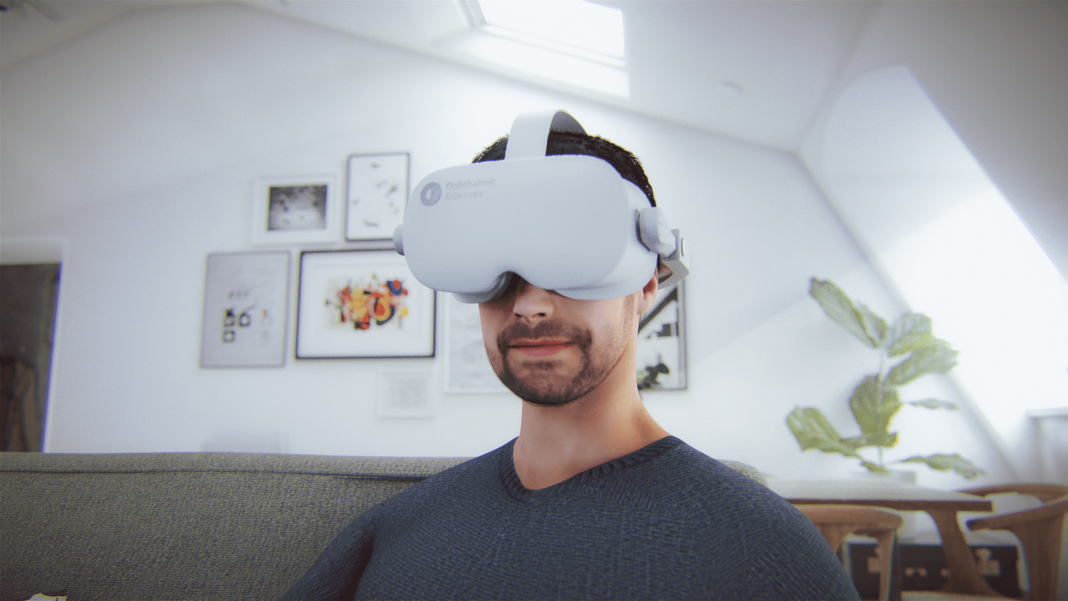Ophthalmic Sciences is unveiling IOPerfect™, the world’s first AI-based contactless intraocular pressure (IOP) measuring device. The proprietary technology, which combines AI-based visual analysis in a VR-like headset, allows tele-diagnosis and remote monitoring of glaucoma. With around 75 million patients globally, glaucoma is the second leading cause for blindness, which the novel technology may help prevent.
Patients can easily and safely wear the VR-like headset to monitor their IOP (fluid pressure inside the eyes) any time of the day at home without the need for eye drops or constant calibration. The test is performed in under two minutes, and is unaffected by corneal thickness, with its proprietary algorithm providing reliable AI-based image processing analysis of vascular pressure response.
“We are excited to have our technology serve as a meaningful tool to help fight the glaucoma epidemic and prevent millions from going blind,” says Ariel Weinstein, CEO, Ophthalmic Sciences. “Growing exposure to phone and computer screens appears to be linked to increased glaucoma prevalence. Along with an ageing population, the risk keeps getting higher, increasing the need for early diagnosis. But most importantly, the past year has proven the value of tele-diagnosis and this fact has attracted significant attention from clinicians and investors in our venture,” adds Weinstein.
“Non-contact, remote measurement of IOP is very challenging, which explains why current glaucoma management is based on infrequent measurements even though IOP fluctuates continuously. Such sporadic monitoring would be unheard of in diabetes or hypertension management which is why I embarked on this journey,” says Noam Hadas, inventor of the technology, Co-Founder and CTO, Ophthalmic Sciences.
Hadas concluded: “Developing the IOPerfect was a very challenging feat, involving a combination of novel mechanics and image processing innovations. All these were brought together to solve the need for a best-in-class system that can provide specialists with the data required to better treat their patients.”
IOPerfect™ applies mild controlled air pressure within the headset while micro-video cameras capture the difference in response to pressure of internal vs. external eye blood vessels. Data is uploaded to a secure cloud where analysis takes place and results can be accessed by the clinician for interpretation.
The IOPerfect™ can be used at home, at eye-care clinics, in emergency rooms, primary care physicians’ offices for at-risk patient screening, nursing homes and by pharmacies offering health services. The solution helps save time for ophthalmologists and optometrists, while improving patient outcomes and increasing revenue for clinics, hospitals, and telehealth providers.
Ophthalmic Sciences has started the regulatory procedures for the IOPerfect™, which is set to be available for sale in the US and Europe in 2023.
The technology forms the basis for Ophthalmic Sciences’ future products, which will include a full eyecare remote diagnostics suite for early detection of cataract, corneal edema and exophthalmia, alongside early identification of central/branch vascular occlusions and ocular motor disorders.
The devices will be available in two versions, the IOPerfect™ and the IOPerfect Plus™, tailored for different use cases. IO Perfect Plus™ can help Ophthalmic Sciences generate a particularly attractive revenue stream, based on offering the product through a SaaS based business model. According to Ophthalmic Sciences, dozens of subjects have already used the device to date as part of R&D and ongoing clinical trials, the results of which are expected to be submitted to the FDA in 2022. The startup has already secured part of the new capital it is now raising. The funding will allow the company to extend partnerships that will help bring the devices to the market.



